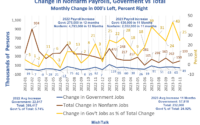It’s hard to know how much the U.S. Federal Reserve will need to do to get inflation under control. But one thing is certain: To be effective, it’ll have to inflict more losses on stock and bond investors than it has so far.
If Stocks Don’t Fall, the Fed Needs to Force Them
Whether that proves right will depend on a number of hard-to-predict developments. How quickly will inflation come down? Where will it bottom out as the economy reopens, demand shifts from services to goods and supply-chain disruptions ease? What will happen in the labor market, where annual wage inflation is running at more than 5% and the unemployment rate is on track to reach its lowest level since the early 1950s within a few months? Will more people come off the sidelines, boosting the labor supply? Together with moderating inflation, this could allow the Fed to stop raising rates at a neutral level of about 2.5%. Or a tightening labor market and stubborn inflation could force the Fed to be a lot more aggressive.
Among the biggest uncertainties: How will the Fed’s tightening affect financial conditions, and how will those conditions affect economic activity? This is central to Fed Chair Jerome Powell’s thinking about the transmission of monetary policy. As he put it in his March press conference: “Policy works through financial conditions. That’s how it reaches the real economy.”
He’s right. In contrast to many other countries, the U.S. economy doesn’t respond directly to the level of short-term interest rates. Most home borrowers aren’t affected, because they have long-term, fixed-rate mortgages. And, again in contrast to many other countries, many U.S. households do hold a significant amount of their wealth in equities. As a result, they’re sensitive to financial conditions: Equity prices influence how wealthy they feel, and how willing they are to spend rather than save.
So far, the Fed’s removal of stimulus hasn’t had much effect on financial conditions. The S&P 500 index is down only about 4% from its peak in early January, and still up a lot from its pre-pandemic level. Similarly, the yield on the 10-year Treasury note stands at 2.5%, up just 0.75 percentage point from a year ago and still way below the inflation rate. This is happening because market participants expect higher short-term rates to undermine economic growth and force the Fed to reverse course in 2024 and 2025 — but these very expectations are preventing the tightening of financial conditions that would make such an outcome more likely.
Investors should pay closer attention to what Powell has said: Financial conditions need to tighten. If this doesn’t happen on its own (which seems unlikely), the Fed will have to shock markets to achieve the desired response. This would mean hiking the federal funds rate considerably higher than currently anticipated. One way or another, to get inflation under control, the Fed will need to push bond yields higher and stock prices lower.
This column does not necessarily reflect the opinion of the editorial board or Bloomberg LP and its owners.
Bill Dudley, a Bloomberg Opinion columnist and senior adviser to Bloomberg Economics, is senior adviser to the Griswold Center for Economic Policy Studies at Princeton University. He served as president of the Federal Reserve Bank of New York from 2009 to 2018, and as vice chairman of the Federal Open Market Committee. He was previously chief U.S. economist at Goldman Sachs.
More stories like this are available on bloomberg.com/opinion
[ad_2]
Source link


